Mercedes-Benz is not built for guesswork. Every system, from the ECU to the climate control, is engineered with layers of encrypted communication. Generic scanners? They miss the details. Mercedes Diagnostic Tools are not just helpful; they are the only way to achieve diagnostic accuracy. These tools speak the same language as the vehicle, unlocking data that drives real decisions, not assumptions.
In Dubai’s heat, where components are pushed to their limits, precision repairs depend on knowing exactly what’s wrong, not what might be. That’s why workshops that specialize in Mercedes-Benz service rely on tools designed for the brand. If the goal is speed, accuracy, and zero comebacks, then the right diagnostic tools are not negotiable. They’re the starting point.
What Makes Mercedes Diagnostic Tools Unique | Why Generic Scanners Miss the Mark
Let’s be honest, Mercedes-Benz vehicles are not built for shortcuts. You plug in a generic scanner, and it gives you a vague fault code. Maybe something about the transmission. Maybe not. You’re left guessing, and in a high-pressure workshop, that’s not good enough.
Mercedes Diagnostic Tools are designed to go far deeper. These tools don’t just skim the surface; they dive into the proprietary architecture that defines every modern Mercedes. We’re talking about encrypted module communication, multiplex wiring, and a layered CAN bus system that controls everything from adaptive headlights to air suspension.
Star Diagnosis, for example, isn’t just a scanner. It’s a full diagnostic suite that reads live data, activates sensors, and performs SCN coding. It’s the difference between knowing what’s wrong and knowing what to do about it. Generic tools? They miss half the modules. They can’t access the encrypted zones. They don’t speak Mercedes.
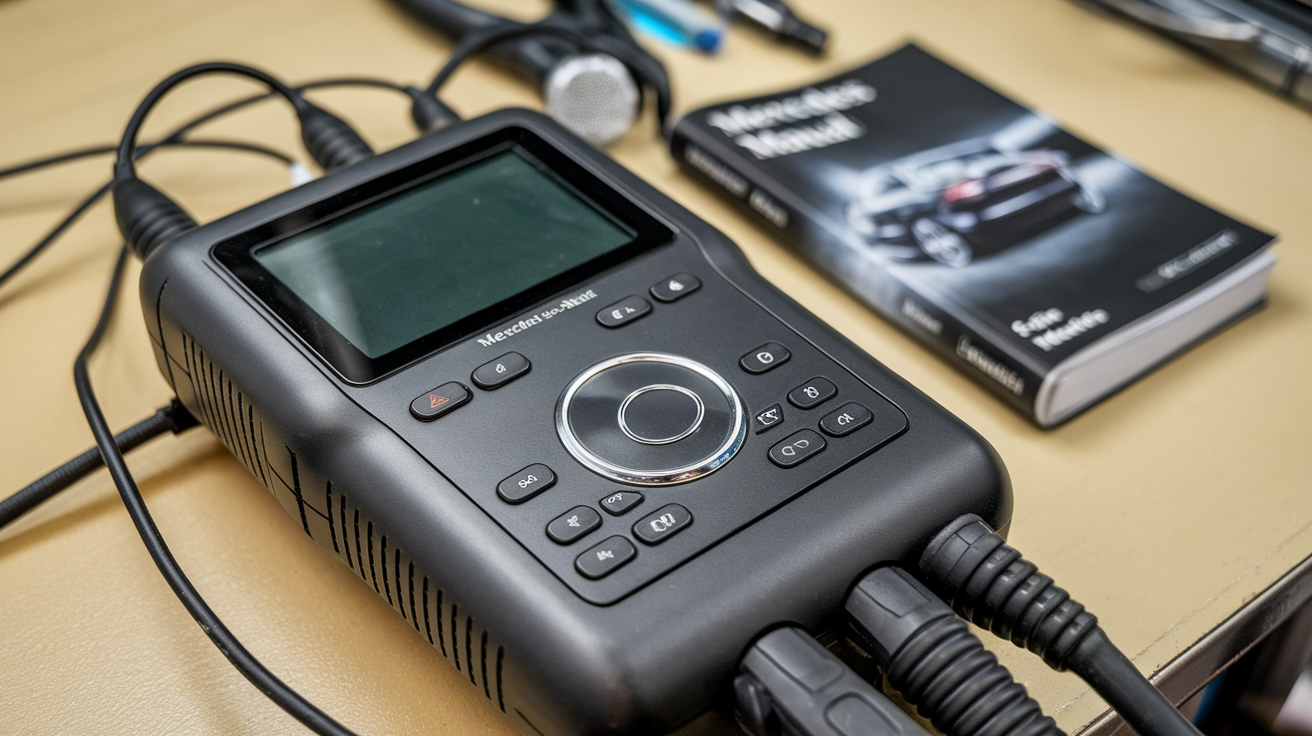
Core Diagnostic Platforms Used by Mercedes Technicians | What Powers the Deep Dive
You walk into a Mercedes workshop in Dubai. The technician isn’t fumbling with a universal scanner. He’s booting up Mercedes Diagnostic Tools, the kind that don’t just read codes, they read the car’s mind. Let’s break it down.
- Xentry Diagnostics is the flagship. It’s the official software used across authorized service centers. It connects to every control unit, runs guided tests, and even handles SCN coding. Whether it’s a 2025 S-Class or a 2012 Sprinter, Xentry knows how to talk to it. Star DAS is the legacy system. Still used for older models, especially pre-2004 vehicles. It’s stable, reliable, and still relevant in workshops that see classics.
- SDconnect is the hardware bridge. It links the car to the diagnostic software. Think of it as the translator between the vehicle’s encrypted language and your technician’s screen.
And then there’s HHT-WIN, a tool that refuses to die. It’s used for vintage models, especially those from the ‘90s. Not flashy, but it gets the job done. Mercedes Diagnostic Tools aren’t just tools. They’re the backbone of every serious repair. Without them, you’re flying blind.
System-Specific Diagnostics | From Engine to Infotainment
Mercedes doesn’t just build cars; they build networks of control units. Each one speaks in encrypted signals, and unless you’ve got the right translator, you’re lost. That’s why Mercedes Diagnostic Tools are the backbone of every serious repair. Let’s break it down by system and by tool.
- Engine Management
Tool used: Xentry Diagnostics
Reads live data from fuel trims, ignition timing, oxygen sensors, and turbo boost levels. It also performs ECU resets and adaptation procedures. - ECU diagnostics Transmission Control
Tool used: Star DAS (for older models), Xentry Diagnostics (for newer)
Accesses shift logic, torque converter status, and clutch adaptation values. Helps isolate hard-to-catch intermittent faults. - Air Suspension
Tool used: SDconnect with Xentry
Calibrates ride height, checks valve block integrity, and monitors compressor cycles. Crucial in Dubai’s climate, where suspension wear accelerates. - Infotainment (COMAND system)
Tool used: Xentry Diagnostics
Diagnoses audio faults, navigation errors, and fiber-optic loop breaks.
Generic tools? They’ll give you a fault code. Maybe. But Mercedes Diagnostic Tools? They give you the full picture, fast, accurate, and module-specific. Always run a complete scan before isolating faults. Mercedes systems often cascade errors across modules. Mercedes Diagnostic Tools are not just part of the process; they are the process.
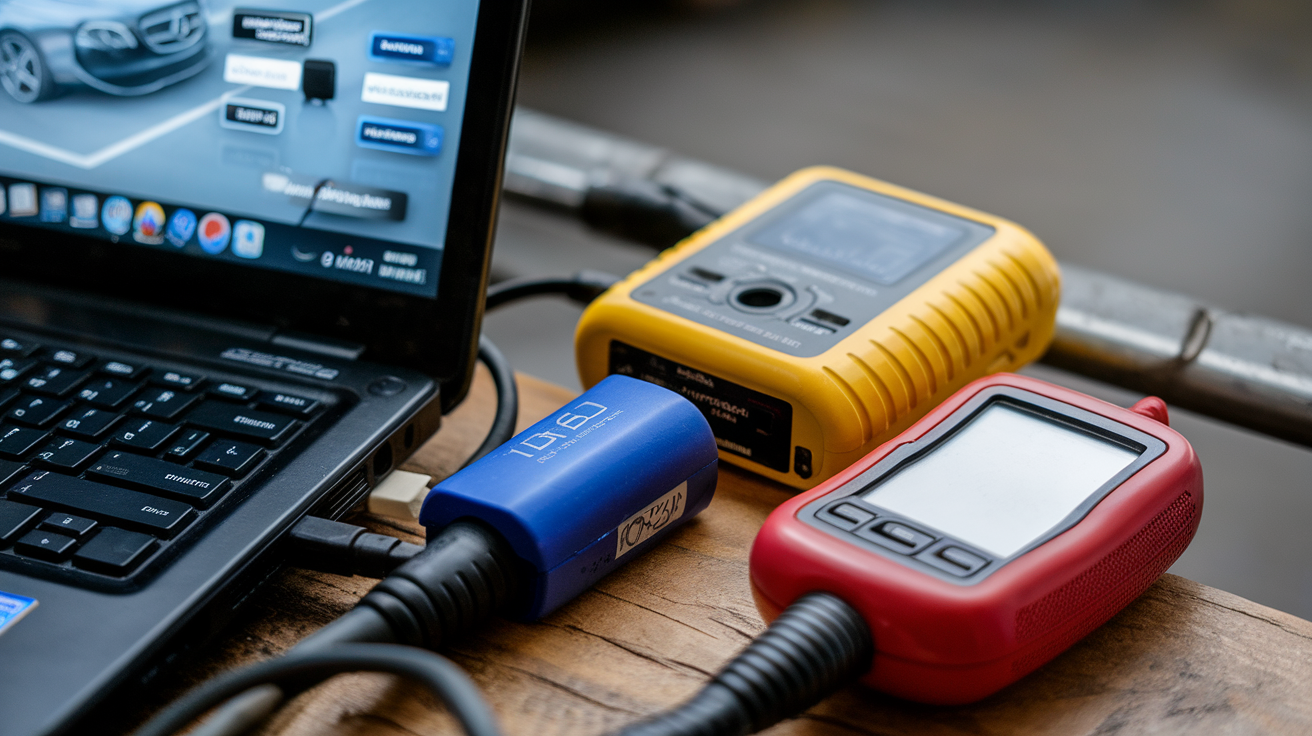
Essential Hardware Interfaces and Connectors | What Makes the Connection Count
Before any diagnostic scan begins, there’s a moment of truth, connecting the tool to the vehicle. And with Mercedes-Benz, that connection isn’t always straightforward. You’re dealing with encrypted modules, legacy systems, and evolving hardware standards. Mercedes Diagnostic Tools depend on the right physical interface to unlock full access. Without the correct connector, even the most advanced software is just a blank screen.
Legacy vs Modern Interfaces | Matching the Connector to the Vehicle
Mercedes has used multiple connector types over the years. Knowing which one to use isn’t optional; it’s critical. Here’s how Mercedes Diagnostic Tools interface with different generations of vehicles:
- 38-Pin Connector (Legacy Models)
Used in pre-2002 vehicles, typically located in the engine bay
Gives access to ABS, transmission, airbag, and body control modules
Required for full diagnostics on older E-Class, S-Class, and C-Class models - OBD-II Interface (Modern Models)
Found under the dashboard in vehicles post-2002
Standardized port, but Mercedes uses encrypted communication protocols
Needs compatible software and a multiplexer to access all modules
Keyword: OBD-II interface - SDconnect Multiplexer
Acts as the bridge between the car and diagnostic software
Supports both 38-pin and OBD-II connections
Translates encrypted CAN signals for tools like Xentry and Star DAS
Keyword: SDconnect multiplexer
Mercedes Diagnostic Tools are only effective when paired with the right hardware. Miss the interface, and you miss the data. Always verify the connector type before starting diagnostics. Using the wrong interface can block access to critical systems.
Real-Time Data Logging and Fault Code Interpretation
A warning light flashes. The customer’s worried. But the real story? It’s buried deep in the control units. And unless you’ve got the right tools, you’re chasing shadows. Mercedes Diagnostic Tools don’t just read fault codes; they capture the moment a fault occurred, log live data, and help technicians understand what went wrong and why.
Especially in Dubai, where heat and traffic stress systems constantly, this level of insight isn’t optional. Intermittent faults are the hardest to catch. They come and go, often without leaving a trace. That’s why technicians rely on tools that offer real-time monitoring and snapshot data.
- Live Data Stream: Tracks sensor values in real time, including airflow, throttle position, coolant temperature, and more. Helps identify performance drops before they trigger a fault
- Freeze Frame Data: Captures a snapshot of system conditions at the exact moment a fault occurred
Useful for diagnosing temperature-related failures or voltage drops - Fault Memory Access: Retrieves stored Diagnostic Trouble Codes (DTCs) from all modules
- DTC Analysis: Goes beyond the code, interprets what triggered it, which system it affects, and how it cascades
Mercedes Diagnostic Tools give you the full picture. Not just what failed, but how, when, and under what conditions.
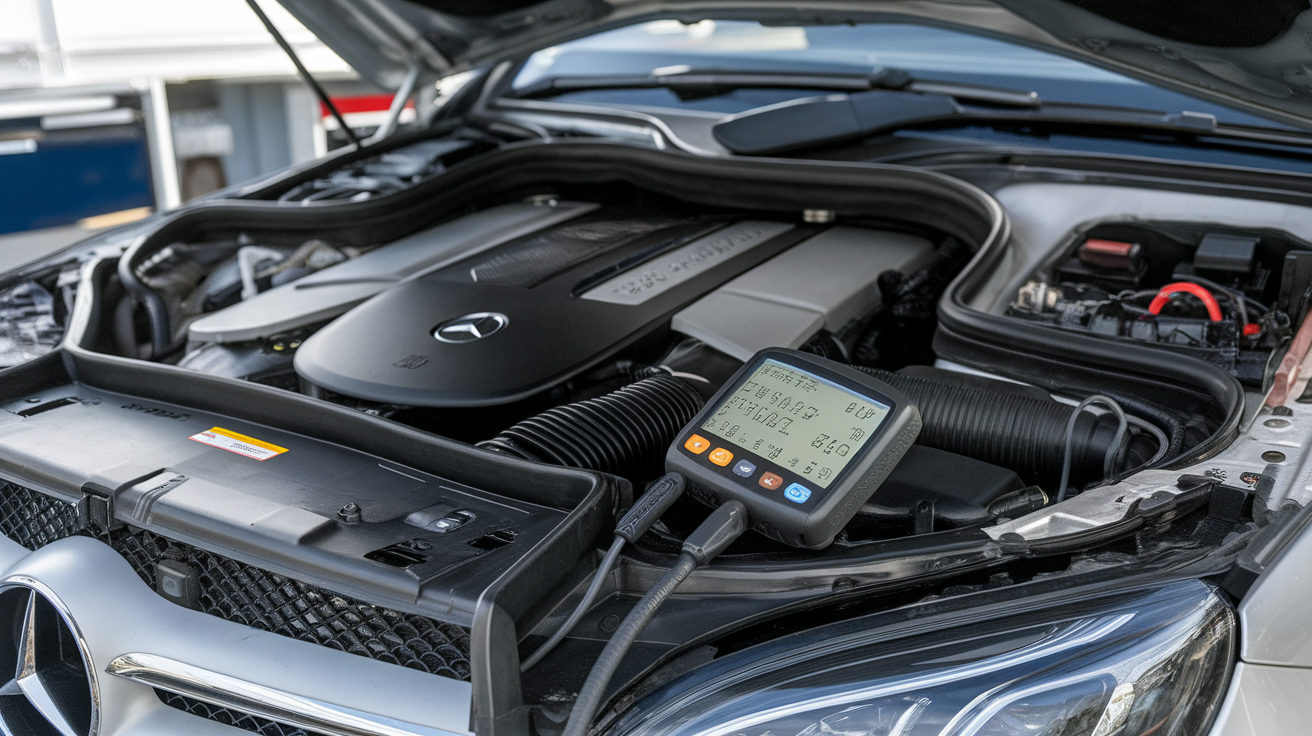
Temperature-Sensitive Diagnostics in Dubai’s Climate
Dubai’s relentless heat isn’t just uncomfortable, it’s diagnostic gold. AC systems here face extreme thermal stress, and Mercedes Diagnostic Tools are engineered to catch what the naked eye can’t.
Technicians rely on advanced scanners like the Foxwell NT710 and XTool D8 to access AC-specific modules, read refrigerant pressure, and monitor compressor performance. These tools go beyond generic OBD2 readers; they’re built for climate control precision.
Key Capabilities in AC Diagnostics
- Thermal Sensors
Monitor evaporator, coolant, and ambient temperatures in real time
Crucial for identifying compressor overload or duovalve malfunctions - AC Diagnostics Mode
Accesses hidden fault codes and sensor data via the control panel
Reveals intermittent issues like refrigerant pressure drops or blower voltage spikes - Climate Control Module Analysis
Evaluates fan speed, sun sensor input, and temperature selector response
Helps isolate faults in multi-zone systems under thermal load
Mercedes Diagnostic Tools like the NT710 don’t just read codes; they interpret heat signatures. In Dubai, that’s the difference between a quick fix and a comeback job.
Calibration and Coding | Beyond Fault Detection
Fixing the fault is only half the job. The real magic happens after the repair, when modules are reprogrammed, components are adapted, and systems are recalibrated. That’s where Mercedes Diagnostic Tools go beyond basic troubleshooting.
Whether it’s installing a new fuel control unit or replacing a climate module, SCN coding ensures the software matches the hardware. Tools like the Mercedes-Benz Star Diagnostic Scanner (Xentry) and Autel MS909 allow technicians to perform SCN coding, module adaptation, and software updates with precision. Advanced Functions That Matter.
- SCN Coding
Software Calibration Number coding re-flashes control modules with factory data
Required after replacing ECU, transmission controllers, or fuel systems - Module Adaptation
Syncs new components, like throttle bodies or steering racks, with the vehicle’s existing systems
Prevents miscommunication between modules and ensures smooth operation - Software Updates
Loads the latest firmware into control units for improved performance and bug fixes
Especially critical for hybrid systems and advanced driver-assist features
Mercedes Diagnostic Tools don’t just fix, they teach. Every update, every adaptation, every line of code ensures the vehicle performs like it just rolled off the line.
Workflow Integration | How Diagnostic Tools Shape Repair Strategy
In a high-pressure workshop, time isn’t just money; it’s reputation. That’s why Mercedes Diagnostic Tools are more than scanners. They’re strategic instruments that guide every step of the service workflow, from intake to delivery. By integrating fault detection, live data, and coding capabilities, these tools reduce guesswork, improve technician efficiency, and streamline repair planning. Step-by-Step, How Mercedes Diagnostic Tools Drive the Service Workflow.
- Initial Scan & Fault Memory Retrieval: Tools like the YOUCANIC Pro Scanner or Xentry DAS instantly pull DTCs and freeze frame data
Technicians get a snapshot of what’s wrong before touching a wrench - Live Data Monitoring for Confirmation: Real-time sensor readings validate fault codes and expose hidden issues. Ensures accurate diagnosis and avoids unnecessary part replacements
- Repair Planning & Part Matching: Based on diagnostic output, technicians plan the repair path. Modules are matched, parts ordered, and labor time estimated precisely
- Post-Repair Calibration & Coding: SCN coding and module adaptation ensure new components integrate seamlessly. Software updates finalize the job and restore factory-level performance
- Final Verification & Customer Report: A closing scan confirms fault clearance and system integrity. Builds trust and documents the full service workflow
Mercedes Diagnostic Tools don’t just support repairs, they shape them.
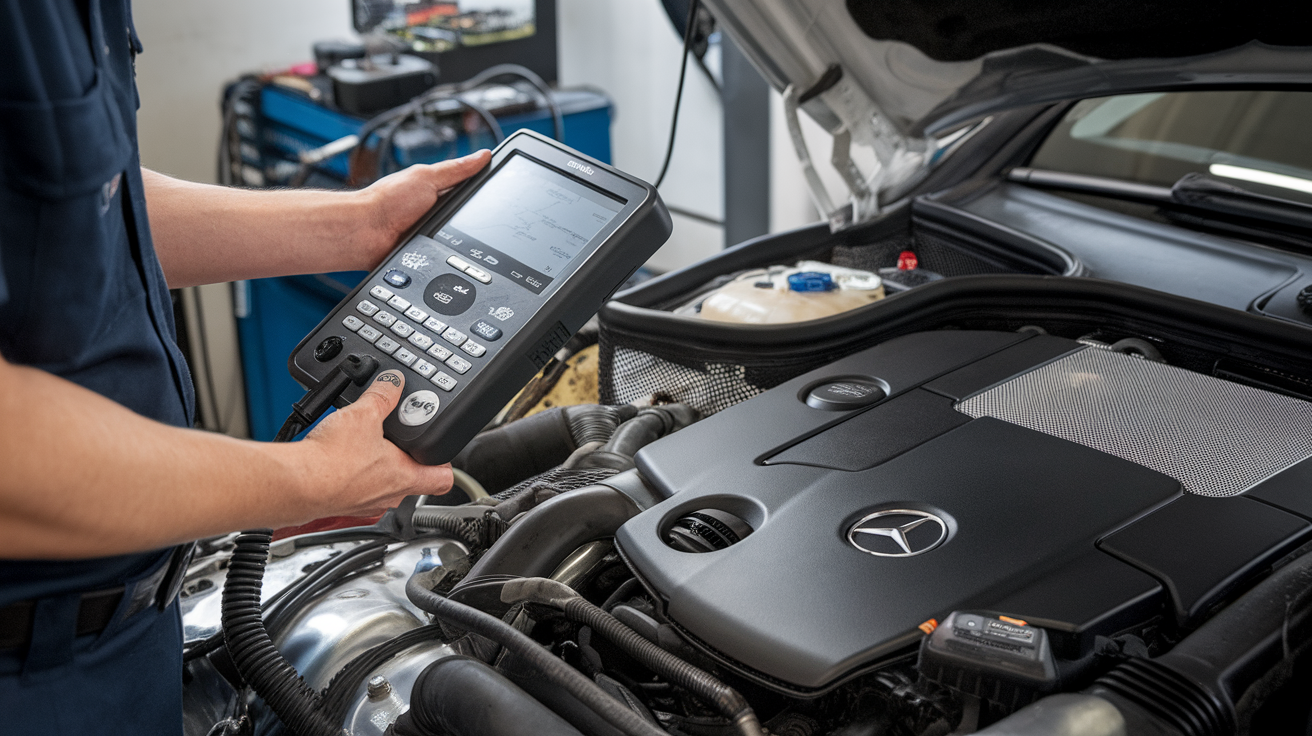
Tool Maintenance and Software Licensing | Keeping Diagnostics Sharp
Even the best Mercedes Diagnostic Tools need upkeep. Without regular updates and calibration, accuracy drops, and so does technician confidence. From firmware updates to license renewal, maintaining these tools is essential for consistent performance and compatibility with newer vehicle models. Here are the key Maintenance Practices
- Firmware Updates
Tools like Xentry and Autel MS909 require periodic firmware refreshes to stay compatible with evolving control units
Updates improve speed, fix bugs, and unlock new diagnostic features - License Renewal
Most professional-grade tools operate on annual or biannual software subscriptions
Renewal ensures access to SCN coding, module adaptation, and cloud-based diagnostics - Tool Calibration
Physical calibration, especially for multimeters and sensor probes, ensures accurate readings. Recommended every 6–12 months, depending on usage intensity
Neglecting maintenance can lead to misdiagnosis, wasted labor, and costly rework. Mercedes Diagnostic Tools are only as good as the care they receive.
Case Studies | Precision Repairs Enabled by Mercedes Diagnostic Tools
Complex faults don’t just need good technicians; they need the right tools. These case studies show how Mercedes Diagnostic Tools turned confusion into clarity and breakdowns into breakthroughs.
- Hybrid Isolation Fault – Mercedes C-Class
A hybrid C-Class arrived unable to start, flashing a red battery malfunction light. Using Xentry, technicians retrieved fault code P1CA100 – Isolation Fault. Initial tests pointed to the HV battery, but deeper probing revealed shorted pins in the electric motor. The motor was removed, inspected, and confirmed as the root cause. Without Mercedes Diagnostic Tools, this level of fault isolation would’ve been impossible.
- CAN Bus Failure – Mercedes GL W164
The GL W164 displayed multiple system failures, DSR, ESP, Parktronic, and more. Xentry diagnostics traced the issue to the Central Gateway module. Physical inspection revealed water damage and oxidized wiring beneath the seat. After cleaning and verifying the CAN line resistance, the system was restored. A textbook example of repair success driven by precise diagnostics.
Mercedes Diagnostic Tools don’t just read codes, they guide decisions, uncover hidden faults, and save thousands in misdiagnosed repairs.
Choosing the Right Tool for Your Mercedes Workshop | Fit the Tool to the Task
Not all Mercedes Diagnostic Tools are created equal. Selecting the right one depends on your workshop’s size, repair scope, and the vehicle models you service. Smart Tool Selection Starts Here:
- Workshop Needs
Small garages may benefit from compact tools like the YOUCANIC Pro Scanner, ideal for quick fault reads and basic coding
Larger operations should consider full-suite systems like Xentry DAS or Autel MS909 for SCN coding, module adaptation, and hybrid diagnostics - Vehicle Compatibility
Older models (1996–2005) may only need basic OBD2 support
Newer vehicles with ADAS, hybrid systems, or multi-zone climate control require advanced software and hardware compatibility - Repair Scope
If your team handles everything from AC diagnostics to ECU replacements, invest in tools with firmware update support and license renewal options
Mercedes Diagnostic Tools should match your ambition, not just your budget.
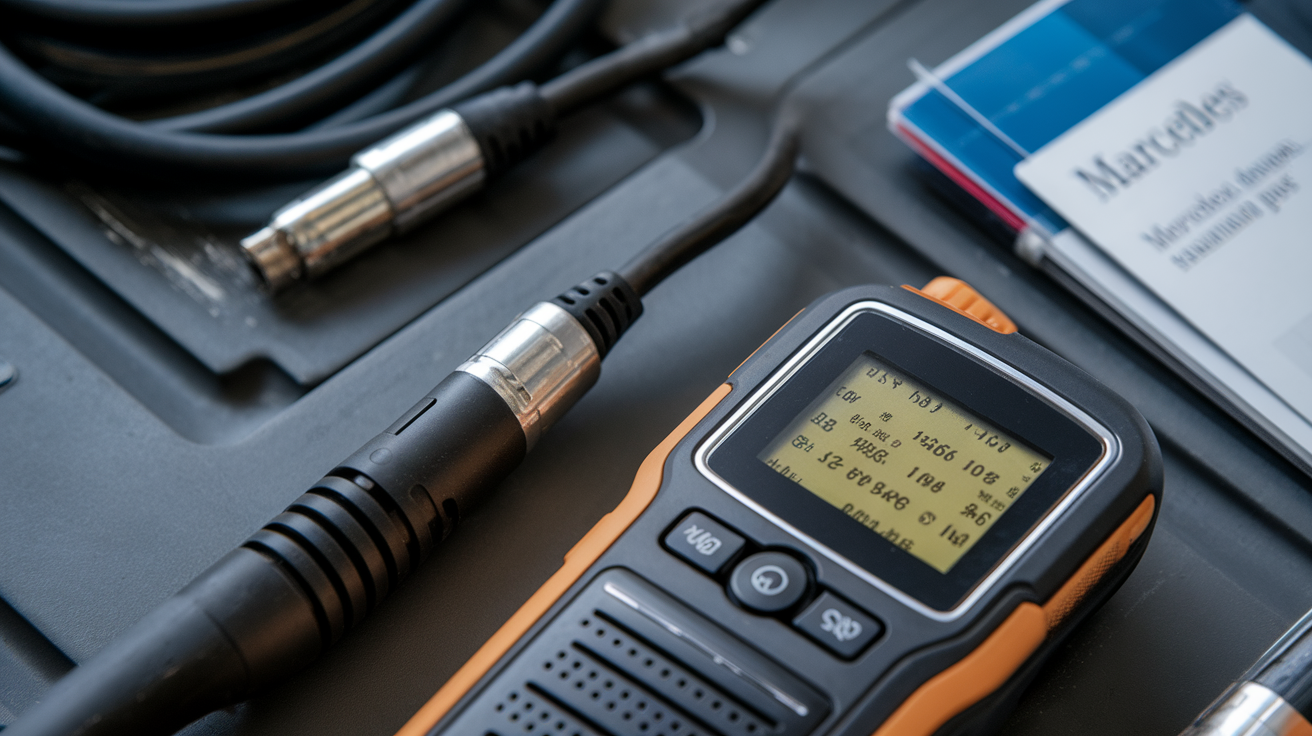
Precision Starts with the Right Diagnostic Tools
In today’s high-tech workshops, guesswork is obsolete. Mercedes Diagnostic Tools empower technicians to deliver pinpoint accuracy, from fault isolation to post-repair coding. Whether it’s hybrid calibration, AC diagnostics, or SCN coding, the right tool transforms service from reactive to proactive.
Investing in professional-grade tools like Xentry, YOUCANIC, or Autel MS909 isn’t just about features; it’s about repair accuracy and long-term service excellence. With regular updates, proper calibration, and skilled usage, these tools become the backbone of a workshop’s reputation. Master the tools, and you master the car.





